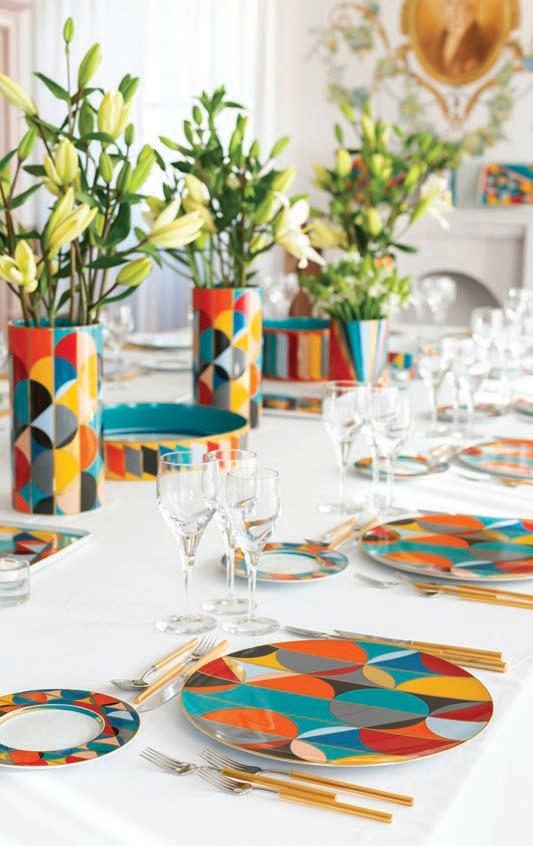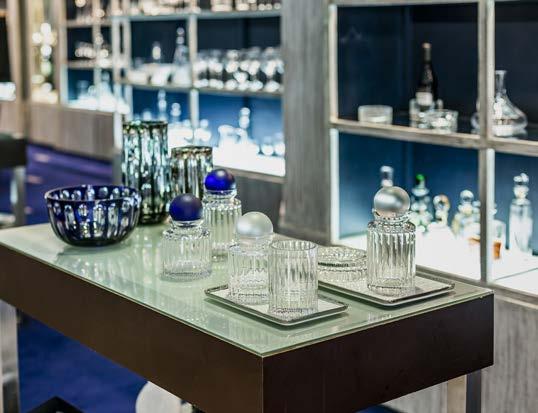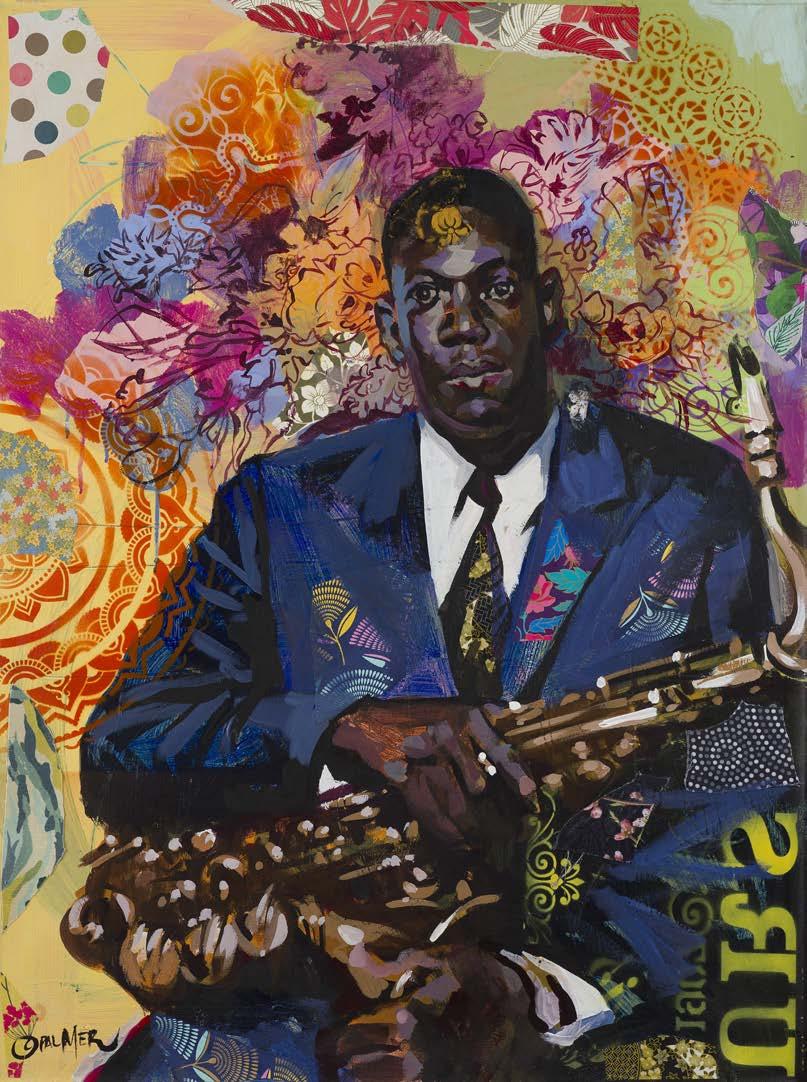
6 minute read
Tablewear
by Martin
TABLEWEAR. NOT A TYPO. VISTA ALEGRE,A NATIONAL TREASURE THAT MORE THAN JUST SETTING TABLES BEAUTIFULLY, HAS THE POWER TO DRESS UP A DINING ROOM WITH SHOW-STOPPING CERAMIC AND GLASS PIECES
Words: SANDRA GATO
S
AA WAY OF OF keeping
you
Interested In What
follows, I will start with a number: Vista Alegre will be 200 years old next year and many surprises are being prepared to celebrate this glorious birthday of the famous Portuguese tableware brand.
And it is not just famous here and mentioned on every wedding list of the past two centuries. But it is known and recognised for its unique personality throughout the world.
In 2001, the name of the brand changed to Vista Alegre Atlantis Group, when a fusion with the well-known glass brand occurred.
So, when you say Vista Alegre today you can be talking about tablewear, glass, crystal, cutlery and textiles. And recently, the house launched a home fragrance line with the most wonderful candles...
If you were a child growing up in Portugal, Vista Alegre is, most probably, the brand you’ll have in your adult home. All the major national hotels use it (the brand also does its own hotelware), and its main collections are easily spotted because of the bold imaginative designs.
Bordallo Pinheiro, on the other hand, is creativity in the form of the most incredible – and sometimes provocative – ceramic pieces. We all have some favourites and, in the past decade, what used to be such Portuguese icons – the sardine, the cabbage, the swallow – flew to other countries and gained an international status.
Lucky enough to be able to visit the three factories recently, my already enormous respect for the brands that form the group was taken to an even higher level once I saw the craftsmanship and talent that is so evident throughout the collections coming together.
Vista alegre: the vision
If you want to submerge yourself in the Vista Alegre world – something I highly recommend – you have to head off to Ílhavo, just three kilometres from the beautiful city of Aveiro in the centre of Portugal, where the Vista Alegre compound is located.
I say compound because it’s much more than just a factory or a museum; it’s a village – a ‘bairro’.
There’s so much to absorb that I advise you to stay at least one night in the Montebelo Vista Alegre Ílhavo Hotel (montebelohotels.com) – yes, they even have a hotel!
The place is divided in three different areas (and moods), all of them at walking distance to the Vista Alegre centre. There you will realise the thinking and planning process of José Ferreira Pinto Basto – the man who founded Vista Alegre in 1824. More than building a ceramics factory, he created a village where his employees could live (some of them still do). So much vision and social conscience two centuries ago!
So, there’s the ‘bairro operário’ – part of it now accomodation belonging to the hotel – where you can still visit the barber shop, the kindergarten, the beautiful theatre, the Nossa Senhora da Penha de França church, the football club... all built thinking about the worker’s needs and wellfare.
Then, of course, there’s the factory, the first in Portugal dedicated to porcelain, where all the magic happens. Many pieces are still handmade and painted by skilfull artists (there’s a painting workshop available so you can test your talent). It really is possible to understand the whole process, from the preparation of the clay to the finishing of the pieces in the oven, and realise why the price cannot be small.
When you see how Amazonia (present in many restaurants) and Futurismo (very recent, with bold colours and exquisite design), to name just two, come to life, you gain a new admiration for the brand. And when visiting the store, where infinite temptations await you, take a look at the Claudia Schiffer butterfly collection: delicate and feminine. The former top model fell in love with Vista Alegre and now is a regular collaborator designer.
You can start or close your visit at the museum. It first opened to the public in 1964 and concentrates on the history and evolution of the brand. There you can observe the giant ovens where hard work took place to create such fragile plates and bowls and cups. Also interesting are the special orders, the bespoke pieces fulfilling demands from all over the world and set at many royal tables.
Atlantis: the craftsmanship
Now, down to Alcobaça, to the Atlantis factory. Once again, the marvel of watching up close how common objects – like drinking glasses – come to life. The thing is, they are not common at all! I am sure anyone who has been living in Portugal for a while has already been to an event or dinner party where the drinks were served in those iconic spiky colour glasses. They are a true classic and have the power to dress up any table setting.
But a crystal factory is as hard – hot, heavy machinery, mostly operated by men – as it is magical. Watching the glass being blown and how the soft paste turns into cristaline pieces is enchanting. In Atlantis all the processes are still manual and that’s what makes it so special. It is a place of craftsmanship and ancient techniques where know-how is valued – they call the main glass blower master...
Besides the many collections and decoration pieces that Atlantis produces, is quite astonishing how many orders – some of which confidential – are placed by ‘special’ clients. A recognition of the pureness of the materials being used, the expertise of the workers, the collaboration of many famous designers and the traditional ways of glass making, these attributes are what makes Atlantis so important.

Bordallo Pinheiro: the provocative fantasy
And last but not at all least: Caldas da Rainha. Since my mother is from this beautiful city, now only a 40-minute drive from Lisbon, I grew up with Raphael Bordallo Pinheiro works. He was born in the 19th century but his provocative creations, some addressing the political system, still feel fresh today. That’s the case of Zé Povinho, a symbol to this day of how we must confront the powers that be.
But he also drew nature, sometimes in an extremely realistic or over the top manner: like the frightened black cat or the bright green frogs.
Before it became a worldwide trend – a brand that you can buy in London or New York’s most exclusive stores – I would dare say all Portuguese children in the 70s and 80s grew up with some of his pieces at home, especially in their grandmother’s houses, where the cabbage collection (still the bestseller) was a must. For us kids at the time, in the verge of entering The New Age, it was just, well yes, ugly. But then we grew up, got tired of all the new millenium minimalism and, validated by decorators from everywhere, we went to fetch our granny’s old Bordallo cabbages from the attic.
Following the needs and likes of the market, many different lines came to life, all colour blasts that we want to eat from.
As the love brand that it is, the question is not if you like it or not but what fruit/vegetable you’re going to choose to take to your table. I was always a strawberry fan but now I am torn between the watermelon and the avocado.
This all sounds a lot of fun – and it is! – but it’s also born of ancient sculpture and painting techniques. And the talent that follows Bordallo’s footsetps and takes it to this century.
There are Vista Alegre stores across the country. Closest to home find them in Algarve Shopping Guia, Portimão, and in the Designer Outlet area of Mar Shopping.


’ M NICK. 30 years old and working a great corporate job in Cape Town. It’s hard work, rewarding but mentally taxing. I’m lusting for adventure, for a break and for something completely different! I realise that South Africa is not where it’s at for many reasons, so I decide to take up my cousin on his offer of a job in the Algarve.

I felt a mixture of excitement and trepidation. Scratch that, I was 30-years-old, all I remember is positive excitement! I remember going down to the local travel agency and picking up a brochure. I took it home and pored over the beautiful images of these glorious cliffs, golden coves highlighting the setting sun and little fishing boats meandering through the bays. A few short weeks later, I was considering my €600 per month, which was nothing compared to the money I earned in South Africa. Had I really done the right thing?
I bought a bicycle and set out on a voyage of discovery, cruising the cliffs and marveling at the natural beauty. I embraced my solitude and I delved deep into the new career move I was planning. I studied hard into the night after my work shift was over. I created free websites for whoever I could and learned the art and science of web design. During the day I roamed the coast, explored the villages and relaxed on the beaches. I learned to embrace solitude and found strength in my own company. It felt good.
I met a wonderful girl but sadly she was only over for the week from the UK. We explored together, heading down to Praia Paraíso just west of Carvoeiro and Praia de Marinha just east of Carvoeiro. It was a magical time, but she had to return to London and her job. I had to go back to my solo routine in paradise.









